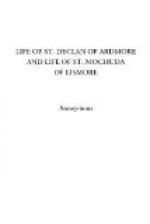Mochuda next directed his steps eastward through Munster and he crossed the river then called Nemh, and now named the Abhainn More. As he crossed he saw a large apple floating in the middle of the ford. This he took up and carried away with him in his hand. Hence (that ford is named) Ath-Ubhla in Fermoy [Ballyhooley]. His attendant asked Mochuda for the apple, but the latter refused to give it saying—“God will work a miracle by that apple and through me to-day: we shall meet Cuana Mac Cailcin’s daughter whose right hand is powerless so that she cannot move it from her side. But she shall be cured by the power of God through this apple.” This was accomplished. Mochuda espied the child playing a game with the other girls in the faithche [lawn] of the Lios. He approached and said to her:—“Take this apple.” She, as usual, put forth her left hand for the fruit. “You shall not get it in that hand, but take it in the other.” The girl full of faith tried to put out the right hand, and on the instant the hand became full of strength and blood and motion so that she took the apple in it. All rejoiced thereat and were amazed at the wonder wrought. That night Cuana said to his daughter: “Choose yourself which you prefer of the royal youths of Munster and whomsoever your choice be I shall obtain in marriage for you.” “The only spouse I shall have,” said she, “is the man who cured my hand.” “Do you hear what she says O Mochuda?” said the king. “Entrust the child to me,” answered Mochuda, “I shall present her as a bride to God who has healed her hand.” Whereupon Cuana gave his daughter Flandnait, together with her dowry and lands on the bank of Nemh, to God and to Mochuda for ever. Cuana was almost incredibly generous. Mochuda took the maiden with him to Rahen where she passed her years happily with the religious women there till Mochuda was expelled by the kings of Tara as you may hear. He took Flandnait with him (from Rahen) in his party to her own native region that she might build herself a cell there. She did build a famous cell at Cluain Dallain in Mochuda’s own parish.




